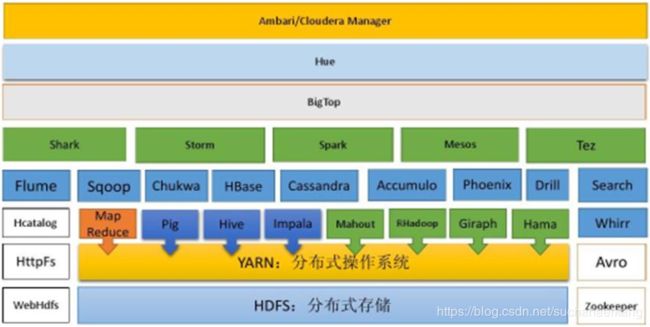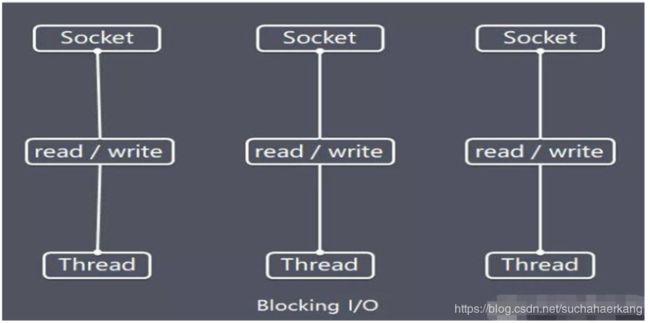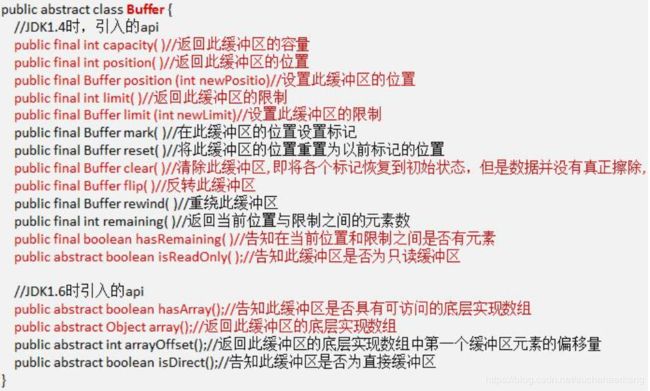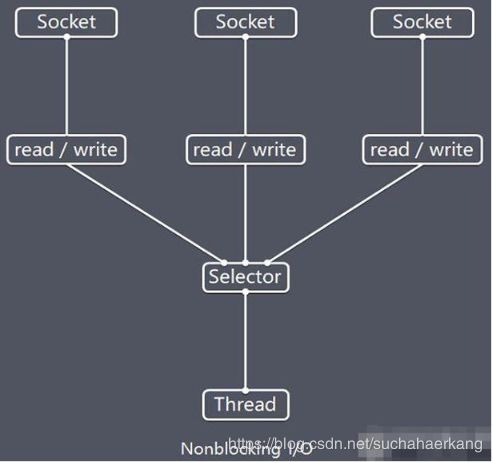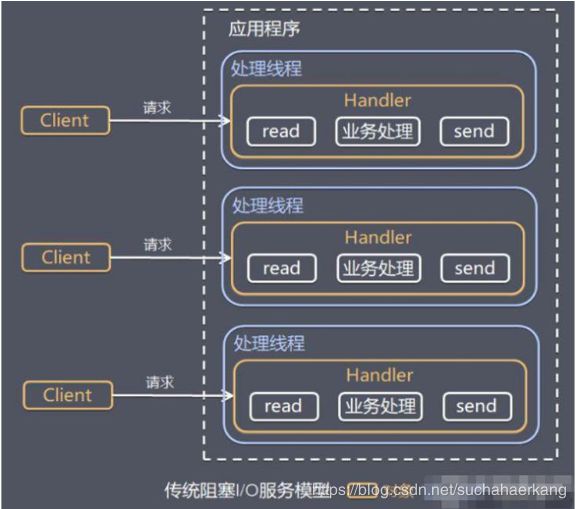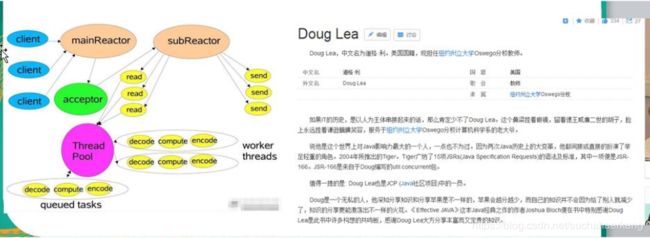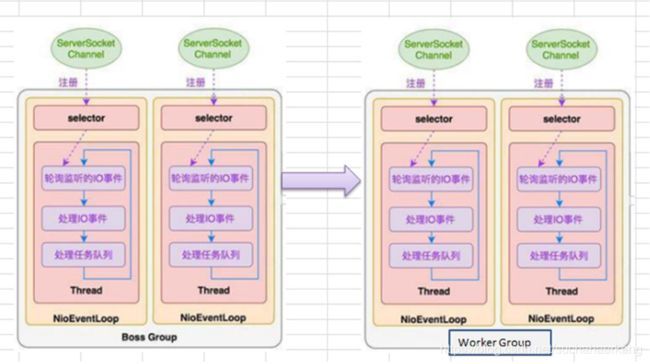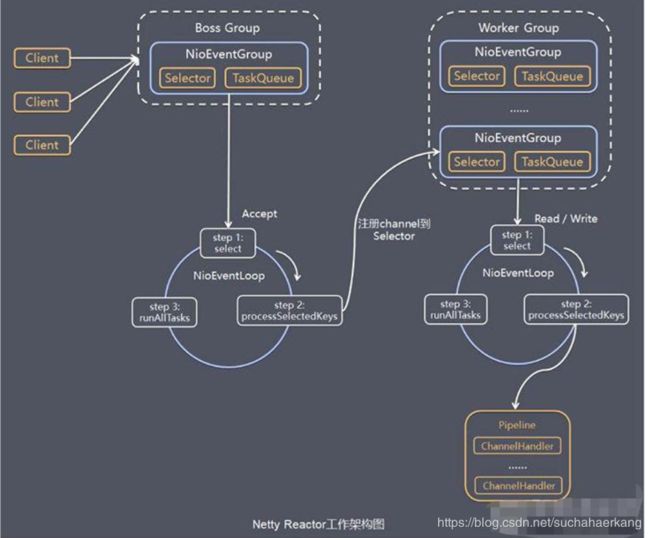Netty学习笔记
文章目录
- 1 Netty介绍和应用场景
- 1.1 Netty的介绍
- 1.2 Netty的应用场景
- 1.2.1 互联网行业
- 1.2.2 互联网行业
- 1.2.3 大数据领域
- 1.2.4 其它开源项目使用到Netty
- 2 JavaBIO编程
- 2.1 I/O模型
- 2.1.1 I/O模型基本说明
- 2.2 BIO、NIO、AIO适用场景分析
- 2.3 JavaBIO基本介绍
- 2.4 JavaBIO工作机制
- 2.5 JavaBIO应用实例
- 2.6 JavaBIO问题分析
- 3 JavaNIO编程
- 3.1 JavaNIO基本介绍
- 3.2 NIO和BIO的比较
- 3.3 NIO三大核心原理示意图
- 3.3.1Selector、Channel和Buffer的关系图(简单版)
- 3.4 缓冲区(Buffer)
- 3.4.1 基本介绍
- 3.4.2 Buffer类及其子类
- 3.4.3 ByteBuffer
- 3.5 通道(Channel)
- 3.5.1 基本介绍
- 3.5.2 FileChannel类
- 3.5.3 应用实例1-本地文件写数据
- 3.5.4 应用实例2-本地文件读数据
- 3.5.5 应用实例3-使用一个Buffer完成文件读取、写入
- 3.5.6 应用实例4-拷贝文件transferFrom方法
- 3.5.7 关于Buffer和Channel的注意事项和细节
- 3.6 Selector(选择器)
- 3.6.1 基本介绍
- 3.6.2 Selector示意图和特点说明
- 3.6.3 Selector类相关方法
- 3.6.4 注意事项
- 3.7 NIO非阻塞网络编程原理分析图
- 3.8 NIO非阻塞网络编程快速入门
- 3.9 SelectionKey
- 3.10 ServerSocketChannel
- 3.11 SocketChannel
- 3.12 NIO网络编程应用实例-群聊系统
- 3.13 NIO与零拷贝
- 3.13.1 零拷贝基本介绍
- 3.13.2 传统IO数据读写
- 3.14 JavaAIO基本介绍
- 3.15 BIO、NIO、AIO对比表
- 4 Netty概述
- 4.1 原生NIO存在的问题
- 4.2 Netty官网说明
- 4.3 Netty的优点
- 4.4 Netty版本说明
- 5 Netty高性能架构设计
- 5.1 线程模型基本介绍
- 5.2 传统阻塞I/O服务模型
- 5.2.1 工作原理图
- 5.2.2 模型特点
- 5.2.3 问题分析
- 5.3 Reactor模式
- 5.3.1 针对传统阻塞I/O服务模型的2个缺点,解决方案:
- 5.3.2 I/O复用结合线程池,就是Reactor模式基本设计思想,如图
- 5.3.3 Reactor模式中核心组成:
- 5.3.4 Reactor模式分类:
- 5.4 单Reactor单线程
- 5.4.1 方案说明:
- 5.4.2 方案优缺点分析:
- 5.5 单Reactor多线程
- 5.5.1 原理图
- 5.5.2 对上图的小结
- 5.5.3 方案优缺点分析:
- 5.6 主从Reactor多线程
- 5.6.1 工作原理图
- 5.6.2 上图的方案说明
- 5.6.3ScalableIOinJava对MultipleReactors的原理图解:
- 5.6.4方案优缺点说明:
- 5.7 Reactor模式小结
- 5.7.1 3种模式用生活案例来理解
- 5.7.2 Reactor模式具有如下的优点:
- 5.8Netty模型
- 5.8.1 工作原理示意图1-简单版
- 5.8.2 对上图说明
- 5.8.3 工作原理示意图2-进阶版
- 5.8.4 工作原理示意图-详细版
- 5.8.5 对上图的说明小结
- 5.8.6 Netty快速入门实例-TCP服务
- 5.8.7 任务队列中的Task有3种典型使用场景
- 5.8.8 方案再说明
- 5.9 异步模型
- 5.9.1 基本介绍
- 5.9.2 Future说明
- 5.9.3 工作原理示意图
- 5.9.4 Future-Listener机制
- 5.10 快速入门实例-HTTP服务
- 6 Netty核心模块组件
- 6.1 Bootstrap、ServerBootstrap
- 6.2 Future、ChannelFuture
- 6.3 Channel
- 6.4 Selector
- 6.5 ChannelHandler及其实现类
- 6.6 Pipeline和ChannelPipeline
- 6.7 ChannelHandlerContext
- 6.8 ChannelOption
- 6.9 EventLoopGroup和其实现类NioEventLoopGroup
- 6.10Unpooled类
- 7 Google Protobuf
- 7.1 编码和解码的基本介绍
- 7.2 Netty本身的编码解码的机制和问题分析
- 7.3 Protobuf
- 8 TCP粘包和拆包及解决方案
- 8.1 TCP粘包和拆包基本介绍
- 8.3TCP粘包和拆包解决方案
- 8.4 看一个具体的实例:
1 Netty介绍和应用场景
1.1 Netty的介绍
- Netty是由JBOSS提供的一个Java开源框架,现为Github上的独立项目。
- Netty是一个异步的、基于事件驱动的网络应用框架,用以快速开发高性能、高可靠性的网络IO程序。

- Netty主要针对在TCP协议下,面向Clients端的高并发应用,或者Peer-to-Peer场景下的大量数据持续传输的应用。
- Netty本质是一个NIO框架,适用于服务器通讯相关的多种应用场景
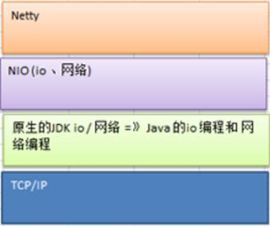
5)要透彻理解Netty,需要先学习NIO,这样我们才能阅读Netty的源码。
1.2 Netty的应用场景
1.2.1 互联网行业
- 互联网行业:在分布式系统中,各个节点之间需要远程服务调用,高性能的RPC框架必不可少,Netty作为异步高性能的通信框架,往往作为基础通信组件被这些RPC框架使用。
- 典型的应用有:阿里分布式服务框架Dubbo的RPC框架使用Dubbo协议进行节点间通信,Dubbo协议默认使用Netty作为基础通信组件,用于实现各进程节点之间的内部通信
1.2.2 互联网行业
- 无论是手游服务端还是大型的网络游戏,Java语言得到了越来越广泛的应用
- Netty作为高性能的基础通信组件,提供了TCP/UDP和HTTP协议栈,方便定制和开发私有协议栈,账号登录服务器
- 地图服务器之间可以方便的通过Netty进行高性能的通信
1.2.3 大数据领域
1.2.4 其它开源项目使用到Netty
网址:https://netty.io/wiki/related-projects.html
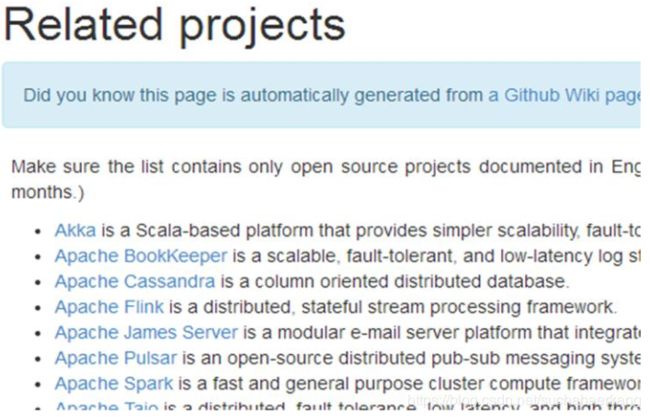
2 JavaBIO编程
2.1 I/O模型
2.1.1 I/O模型基本说明
- I/O 模型简单的理解:就是用什么样的通道进行数据的发送和接收,很大程度上决定了程序通信的性能
- Java共支持3种网络编程模型/IO模式:BIO、NIO、AIO
- JavaBIO:同步并阻塞(传统阻塞型),服务器实现模式为一个连接一个线程,即客户端有连接请求时服务器端就需要启动一个线程进行处理,如果这个连接不做任何事情会造成不必要的线程开销【简单示意图】

- JavaNIO:同步非阻塞,服务器实现模式为一个线程处理多个请求(连接),即客户端发送的连接请求都会注册到多路复用器上,多路复用器轮询到连接有I/O请求就进行处理【简单示意图】

- JavaAIO(NIO.2):异步非阻塞,AIO引入异步通道的概念,采用了Proactor模式,简化了程序编写,有效的请求才启动线程,它的特点是先由操作系统完成后才通知服务端程序启动线程去处理,一般适用于连接数较多且连接时间较长的应用
- 我们依次展开讲解
2.2 BIO、NIO、AIO适用场景分析
- BIO方式适用于连接数目比较小且固定的架构,这种方式对服务器资源要求比较高,并发局限于应用中,JDK1.4以前的唯一选择,但程序简单易理解。
- NIO方式适用于连接数目多且连接比较短(轻操作)的架构,比如聊天服务器,弹幕系统,服务器间通讯等。编程比较复杂,JDK1.4开始支持。
- AIO方式使用于连接数目多且连接比较长(重操作)的架构,比如相册服务器,充分调用OS参与并发操作,编程比较复杂,JDK7开始支持。
2.3 JavaBIO基本介绍
- JavaBIO就是传统的java io编程,其相关的类和接口在java.io
- BIO(blockingI/O):同步阻塞,服务器实现模式为一个连接一个线程,即客户端有连接请求时服务器端就需要启动一个线程进行处理,如果这个连接不做任何事情会造成不必要的线程开销,可以通过线程池机制改善(实现多个客户连接服务器)。【后有应用实例】
- BIO方式适用于连接数目比较小且固定的架构,这种方式对服务器资源要求比较高,并发局限于应用中,JDK1.4以前的唯一选择,程序简单易理解
2.4 JavaBIO工作机制
- 服务器端启动一个ServerSocket
- 客户端启动Socket对服务器进行通信,默认情况下服务器端需要对每个客户建立一个线程与之通讯
- 客户端发出请求后,先咨询服务器是否有线程响应,如果没有则会等待,或者被拒绝
- 如果有响应,客户端线程会等待请求结束后,再继续执行
2.5 JavaBIO应用实例
实例说明:
- 使用BIO模型编写一个服务器端,监听6666端口,当有客户端连接时,就启动一个线程与之通讯。
- 要求使用线程池机制改善,可以连接多个客户端。
- 服务器端可以接收客户端发送的数据(telnet方式即可)。
- 代码演示
package com.wolfx.bio;
import java.io.IOException;
import java.io.InputStream;
import java.net.ServerSocket;
import java.net.Socket;
import java.util.concurrent.ExecutorService;
import java.util.concurrent.Executors;
/**
* @description: bio服务器
* @author: sukang
* @date: 2020-06-11 15:41
*/
public class BIOServer {
public static void main(String[] args) throws Exception{
//线程池机制
//思路
//1.创建一个线程池
//2.如果有客户端连接,就创建一个线程,与之通讯(单独写一个方法)
ExecutorService executorService = Executors.newCachedThreadPool();
//创建ServerSocket
ServerSocket serverSocket = new ServerSocket(6666);
System.out.println("服务器启动了");
while (true){
System.out.println("线程信息id=" + Thread.currentThread().getId() + " 名字=" + Thread.currentThread().getName());
//监听,等待客户端连接
System.out.println("等待连接...");
final Socket socket = serverSocket.accept();
System.out.println("连接到一个客户端");
//就创建一个线程,与之通讯(单独写一个方法)
executorService.execute(new Runnable() {
public void run() {//我们重写
//可以和客户端通讯
handler(socket);
}
});
}
}
//编写一个handler方法,和客户端通讯
public static void handler(Socket socket){
try {
System.out.println("线程信息id="+Thread.currentThread().getId()+"名字="+Thread.currentThread().getName());
byte[] bytes=new byte[1024];
//通过socket获取输入流
InputStream inputStream = socket.getInputStream();
//循环的读取客户端发送的数据
while (true) {
System.out.println("线程信息id="+Thread.currentThread().getId()+"名字="+Thread.currentThread().getName());
System.out.println("read....");
int read = inputStream.read(bytes);
if(read != -1){
System.out.println(new String(bytes,0,read));//输出客户端发送的数据
}else{
break;
}
}
} catch ( IOException e ) {
e.printStackTrace();
}finally {
System.out.println("关闭和client的连接");
try{
socket.close();
}catch(Exception e){
e.printStackTrace();
}
}
}
}
2.6 JavaBIO问题分析
- 每个请求都需要创建独立的线程,与对应的客户端进行数据Read,业务处理,数据Write。
- 当并发数较大时,需要创建大量线程来处理连接,系统资源占用较大。
- 连接建立后,如果当前线程暂时没有数据可读,则线程就阻塞在Read操作上,造成线程资源浪费
3 JavaNIO编程
3.1 JavaNIO基本介绍
- Java NIO全称java non-blocking IO,是指JDK提供的新API。从JDK1.4开始,Java提供了一系列改进的输入/输出的新特性,被统称为NIO(即New IO),是同步非阻塞的
- NIO相关类都被放在java.nio包及子包下,并且对原java.io包中的很多类进行改写。【基本案例】
- NIO有三大核心部分:Channel(通道),Buffer(缓冲区), Selector(选择器)
- NIO是面向缓冲区,或者面向块编程的。数据读取到一个它稍后处理的缓冲区,需要时可在缓冲区中前后移动,这就增加了处理过程中的灵活性,使用它可以提供非阻塞式的高伸缩性网络
- Java NIO的非阻塞模式,使一个线程从某通道发送请求或者读取数据,但是它仅能得到目前可用的数据,如果目前没有数据可用时,就什么都不会获取,而不是保持线程阻塞,所以直至数据变的可以读取之前,该线程可以继续做其他的事情。非阻塞写也是如此,一个线程请求写入一些数据到某通道,但不需要等待它完全写入,这个线程同时可以去做别的事情。【后面有案例说明】
- 通俗理解:NIO是可以做到用一个线程来处理多个操作的。假设有10000个请求过来,根据实际情况,可以分配50或者100个线程来处理。不像之前的阻塞IO那样,非得分配10000个。
- HTTP2.0使用了多路复用的技术,做到同一个连接并发处理多个请求,而且并发请求的数量比HTTP1.1大了好几个数量级
- 案例说明NIO的Buffer
package com.wolfx.nio;
import java.nio.IntBuffer;
/**
* @description:
* @author: sukang
* @date: 2020-06-11 16:34
*/
public class BasicBuffer {
public static void main(String[] args) {
//举例说明Buffer的使用(简单说明)
//创建一个Buffer,大小为5,即可以存放5个int
IntBuffer intBuffer= IntBuffer.allocate(5);
//向buffer存放数据
for(int i=0; i<intBuffer.capacity(); i++){
intBuffer.put(i*2);
}
//如何从buffer读取数据
//将buffer转换,读写切换(!!!)
intBuffer.flip();
while(intBuffer.hasRemaining()){
System.out.println(intBuffer.get());
}
}
}
3.2 NIO和BIO的比较
- BIO以流的方式处理数据,而NIO以块的方式处理数据,块I/O的效率比流I/O高很多
- BIO是阻塞的,NIO则是非阻塞的
- BIO基于字节流和字符流进行操作,而NIO基于Channel(通道)和Buffer(缓冲区)进行操作,数据总是从通道读取到缓冲区中,或者从缓冲区写入到通道中。Selector(选择器)用于监听多个通道的事件(比如:连接请求,数据到达等),因此使用单个线程就可以监听多个客户端通道
3.3 NIO三大核心原理示意图
一张图描述NIO的Selector、Channel和Buffer的关系
3.3.1Selector、Channel和Buffer的关系图(简单版)
- 每个channel都会对应一个Buffer
- Selector对应一个线程,一个线程对应多个channel(连接)
- 该图反应了有三个channel注册到该selector//程序
- 程序切换到哪个channel是由事件决定的,Event就是一个重要的概念
- Selector会根据不同的事件,在各个通道上切换
- Buffer就是一个内存块,底层是有一个数组
- 数据的读取写入是通过Buffer,这个和BIO,BIO中要么是输入流,或者是输出流,不能双向,但是NIO的Buffer是可以读也可以写,需要flip方法切换,channel是双向的,可以返回底层操作系统的情况,比如Linux,底层的操作系统通道就是双向的.
3.4 缓冲区(Buffer)
3.4.1 基本介绍
缓冲区(Buffer):缓冲区本质上是一个可以读写数据的内存块,可以理解成是一个容器对象(含数组),该对象提供了一组方法,可以更轻松地使用内存块,缓冲区对象内置了一些机制,能够跟踪和记录缓冲区的状态变化情况。Channel提供从文件、网络读取数据的渠道,但是读取或写入的数据都必须经由Buffer,如图:【后面举例说明】

3.4.2 Buffer类及其子类
3.4.3 ByteBuffer
从前面可以看出对于Java中的基本数据类型(boolean除外),都有一个Buffer类型与之相对应,最常用的自然是ByteBuffer类(二进制数据),该类的主要方法如下:

3.5 通道(Channel)
3.5.1 基本介绍
- NIO的通道类似于流,但有些区别如下:
通道可以同时进行读写,而流只能读或者只能写
通道可以实现异步读写数据
通道可以从缓冲读数据,也可以写数据到缓冲
- BIO中的stream是单向的,例如FileInputStream对象只能进行读取数据的操作,而NIO中的通道(Channel)是双向的,可以读操作,也可以写操作。
- Channel在NIO中是一个接口
public interface Channel extends Closeable{} - 常用的Channel类有:FileChannel、DatagramChannel、ServerSocketChannel和SocketChannel。【ServerSocketChanne类似ServerSocket,SocketChannel类似Socket】
- FileChannel用于文件的数据读写,DatagramChannel用于UDP的数据读写,ServerSocketChannel和SocketChannel用于TCP的数据读写。
- 图示
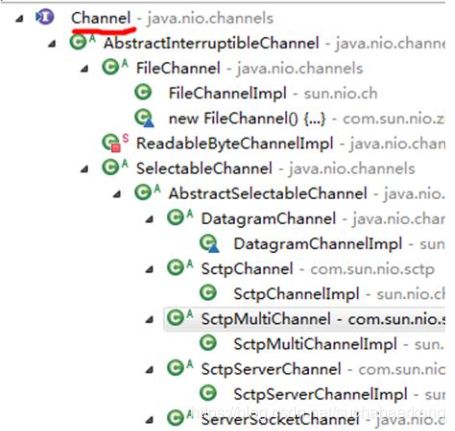
3.5.2 FileChannel类
- FileChannel主要用来对本地文件进行IO操作,常见的方法有
- public int read(ByteBuffer dst),从通道读取数据并放到缓冲区中
- public int write(ByteBuffer src),把缓冲区的数据写到通道中
- public long transferFrom(ReadableByteChannel src,long position,long count),从目标通道中复制数据到当前通道
- public long transferTo(long position,long count,WritableByteChannel target),把数据从当前通道复制给目标通道\
3.5.3 应用实例1-本地文件写数据
实例要求:
- 使用前面学习后的ByteBuffer(缓冲)和FileChannel(通道),将"hello,尚硅谷"写入到file01.txt中
- 文件不存在就创建
- 代码演示
package com.wolfx.nio;
import java.io.FileOutputStream;
import java.nio.ByteBuffer;
import java.nio.channels.FileChannel;
/**
* @description:
* @author: sukang
* @date: 2020-06-12 10:33
*/
public class NIOFileChannel01 {
public static void main(String[] args) throws Exception{
String str = "hello,你好";
//创建一个输出流->channel
FileOutputStream fileOutputStream = new FileOutputStream("d:\\file01.txt");
//通过fileOutputStream获取对应的FileChannel
//这个fileChannel真实类型是FileChannelImpl
FileChannel fileChannel = fileOutputStream.getChannel();
//创建一个缓冲区ByteBuffer
ByteBuffer byteBuffer = ByteBuffer.allocate(1024);
//将str放入byteBuffer
byteBuffer.put(str.getBytes());
//对byteBuffer进行flip
byteBuffer.flip();
//将byteBuffer数据写入到fileChannel
fileChannel.write(byteBuffer);
fileOutputStream.close();
}
}
3.5.4 应用实例2-本地文件读数据
实例要求:
- 使用前面学习后的ByteBuffer(缓冲)和FileChannel(通道),将file01.txt中的数据读入到程序,并显示在控制台屏幕
- 假定文件已经存在
- 代码演示
package com.wolfx.nio;
import java.io.File;
import java.io.FileInputStream;
import java.nio.ByteBuffer;
import java.nio.channels.FileChannel;
/**
* @description:
* @author: sukang
* @date: 2020-06-12 11:10
*/
public class NIOFileChannel02 {
public static void main(String[] args) throws Exception{
//创建文件的输入流
File file=new File("d:\\file01.txt");
FileInputStream fileInputStream = new FileInputStream(file);
//通过fileInputStream获取对应的FileChannel->实际类型 FileChannelImpl
FileChannel fileChannel = fileInputStream.getChannel();
//创建缓冲区
ByteBuffer byteBuffer = ByteBuffer.allocate((int) file.length());
//将通道的数据读入到缓冲区
fileChannel.read(byteBuffer);
//将byteBuffer的字节数据转成String
System.out.println(new String(byteBuffer.array()));
fileInputStream.close();
}
}
3.5.5 应用实例3-使用一个Buffer完成文件读取、写入
实例要求:
- 使用FileChannel(通道)和方法read,write,完成文件的拷贝
- 拷贝一个文本文件1.txt,放在项目下即可
- 代码演示
package com.wolfx.nio;
import java.io.File;
import java.io.FileInputStream;
import java.io.FileOutputStream;
import java.nio.ByteBuffer;
import java.nio.channels.FileChannel;
/**
* @description:
* @author: sukang
* @date: 2020-06-12 11:26
*/
public class NIOFileChannel03 {
public static void main(String[] args) throws Exception{
File file = new File("1.txt");
FileInputStream fileInputStream = new FileInputStream(file);
FileChannel channel = fileInputStream.getChannel();
FileOutputStream fileOutputStream = new FileOutputStream("2.txt");
FileChannel channel1 = fileOutputStream.getChannel();
ByteBuffer byteBuffer = ByteBuffer.allocate(512);
while (true){ //循环读取
//这里有个重要的操作,一定不要忘了
/**
* public final Buffer clear(){
* position=0;
* limit=capacity;
* mark=-1;
* return this;
* }
*/
byteBuffer.clear();//清空buffer
int read = channel.read(byteBuffer);
System.out.println("read=" + read);
if(read == -1){//表示读完
break;
}
//将buffer中的数据写入到channel1 -- 2.txt
byteBuffer.flip();
channel1.write(byteBuffer);
}
fileInputStream.close();
fileOutputStream.close();
}
}
3.5.6 应用实例4-拷贝文件transferFrom方法
- 实例要求:
- 使用FileChannel(通道)和方法transferFrom,完成文件的拷贝
- 拷贝一张图片
- 代码演示
package com.wolfx.nio;
import java.io.FileInputStream;
import java.io.FileOutputStream;
import java.nio.channels.FileChannel;
/**
* @description:
* @author: sukang
* @date: 2020-06-12 13:48
*/
public class NIOFileChannel04 {
public static void main(String[] args) throws Exception{
//创建相关流
FileInputStream fileInputStream = new FileInputStream("a.jpg");
FileOutputStream fileOutputStream = new FileOutputStream("b.jpg");
//创建相关的通道
FileChannel source = fileInputStream.getChannel();
FileChannel target = fileOutputStream.getChannel();
//使用transferFrom完成拷贝
target.transferFrom(source,0, source.size());
source.close();
target.close();
fileInputStream.close();
fileInputStream.close();
}
}
3.5.7 关于Buffer和Channel的注意事项和细节
- ByteBuffer支持类型化的put和get,put放入的是什么数据类型,get就应该使用相应的数据类型来取出,否则可能有BufferUnderflowException异常。[举例说明]
package com.wolfx.nio;
import java.nio.ByteBuffer;
/**
* @description:
* @author: sukang
* @date: 2020-06-12 14:00
*/
public class NIOByteBufferPutGet {
public static void main(String[] args) {
//创建一个Buffer
ByteBuffer buffer = ByteBuffer.allocate(64);
//类型化方式放入数据
buffer.putInt(100);
buffer.putLong(9);
buffer.putChar('苏');
buffer.putShort((short) 4);
//取出
buffer.flip();
System.out.println();
System.out.println(buffer.getInt());
System.out.println(buffer.getLong());
System.out.println(buffer.getChar());
System.out.println(buffer.getShort());
}
}
- 可以将一个普通Buffer转成只读Buffer[举例说明]
package com.wolfx.nio;
import java.nio.ByteBuffer;
/**
* @description:
* @author: sukang
* @date: 2020-06-12 14:10
*/
public class ReadOnlyBuffer {
public static void main(String[] args) {
//创建一个buffer
ByteBuffer buffer = ByteBuffer.allocate(64);
for (int i = 0; i < 64; i++) {
buffer.put((byte) i);
}
//读取
buffer.flip();
//得到一个只读的Buffer
ByteBuffer readOnlyBuffer = buffer.asReadOnlyBuffer();
System.out.println(readOnlyBuffer.getClass());
//读取
while (readOnlyBuffer.hasRemaining()){
System.out.println(readOnlyBuffer.get());
}
readOnlyBuffer.put((byte) 100);
}
}
3.6 Selector(选择器)
3.6.1 基本介绍
- Java的NIO,用非阻塞的IO方式。可以用一个线程,处理多个的客户端连接,就会使用到Selector(选择器)
- Selector能够检测多个注册的通道上是否有事件发生(注意:多个Channel以事件的方式可以注册到同一个Selector),如果有事件发生,便获取事件然后针对每个事件进行相应的处理。这样就可以只用一个单线程去管理多个通道,也就是管理多个连接和请求。【示意图】
- 只有在连接/通道真正有读写事件发生时,才会进行读写,就大大地减少了系统开销,并且不必为每个连接都创建一个线程,不用去维护多个线程
- 避免了多线程之间的上下文切换导致的开销
3.6.2 Selector示意图和特点说明
- Netty的IO线程NioEventLoop聚合了Selector(选择器,也叫多路复用器),可以同时并发处理成百上千个客户端连接。
- 当线程从某客户端Socket通道进行读写数据时,若没有数据可用时,该线程可以进行其他任务。
- 线程通常将非阻塞IO的空闲时间用于在其他通道上执行IO操作,所以单独的线程可以管理多个输入和输出通道。
- 由于读写操作都是非阻塞的,这就可以充分提升IO线程的运行效率,避免由于频繁I/O阻塞导致的线程挂起。
- 一个I/O线程可以并发处理N个客户端连接和读写操作,这从根本上解决了传统同步阻塞I/O一连接一线程模型,架构的性能、弹性伸缩能力和可靠性都得到了极大的提升。
3.6.3 Selector类相关方法
3.6.4 注意事项
- NIO中的ServerSocketChannel功能类似ServerSocket,SocketChannel功能类似Socket
- selector相关方法说明
selector.select()//阻塞
selector.select(1000);//阻塞1000毫秒,在1000毫秒后返回
selector.wakeup();//唤醒selector
selector.selectNow();//不阻塞,立马返还
3.7 NIO非阻塞网络编程原理分析图
NIO非阻塞网络编程相关的(Selector、SelectionKey、ServerScoketChannel和SocketChannel)关系梳理图
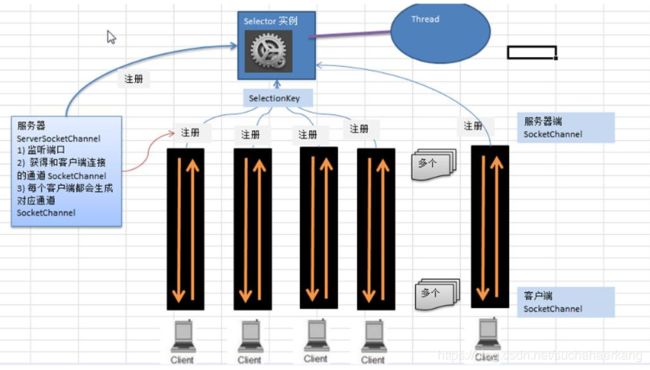
对上图的说明:
- 当客户端连接时,会通过ServerSocketChannel得到SocketChannel
- Selector进行监听select方法,返回有事件发生的通道的个数.
- 将socketChannel注册到Selector上,register(Selectorsel,intops),一个selector上可以注册多个SocketChannel
- 注册后返回一个SelectionKey,会和该Selector关联(集合)
- 进一步得到各个SelectionKey(有事件发生)
- 在通过SelectionKey反向获取SocketChannel,方法channel()
- 可以通过得到的channel,完成业务处理
3.8 NIO非阻塞网络编程快速入门
案例要求:
- 编写一个NIO入门案例,实现服务器端和客户端之间的数据简单通讯(非阻塞)
- 目的:理解NIO非阻塞网络编程机制
- 代码演示
NIOServer
package com.wolfx.nio;
import java.net.InetSocketAddress;
import java.nio.ByteBuffer;
import java.nio.channels.*;
import java.util.Iterator;
import java.util.Set;
/**
* @description:
* @author: sukang
* @date: 2020-06-12 15:29
*/
public class NIOServer {
public static void main(String[] args) throws Exception{
//创建ServerSocketChannel->ServerSocket
ServerSocketChannel serverSocketChannel = ServerSocketChannel.open();
//得到一个Selecor对象
Selector selector = Selector.open();
//绑定一个端口6666,在服务器端监听
serverSocketChannel.socket().bind(new InetSocketAddress(6666));
//设置为非阻塞
serverSocketChannel.configureBlocking(false);
//把serverSocketChannel注册到selector关心事件为OP_ACCEPT
serverSocketChannel.register(selector, SelectionKey.OP_ACCEPT);
//循环等待客户端连接
while (true){
//这里我们等待1秒,如果没有事件发生,返回
if(selector.select(1000) == 0){//没有事件发生
System.out.println("服务器等待1秒,无连接");
continue;
}
//如果返回的>0,就获取到相关的selectionKey集合
//1.如果返回的>0,表示已经获取到关注的事件
//2.selector.selectedKeys()返回关注事件的集合
//通过selectionKeys反向获取通道
Set<SelectionKey> selectionKeys = selector.selectedKeys();
//遍历Set,使用迭代器遍历
Iterator<SelectionKey> keyIterator = selectionKeys.iterator();
while (keyIterator.hasNext()){
//获取到SelectionKey
SelectionKey key = keyIterator.next();
//根据key对应的通道发生的事件做相应处理
if(key.isAcceptable()){ //如果是OP_ACCEPT,有新的客户端连接
//给改客户端生成一个SocketChannel
SocketChannel socketChannel = serverSocketChannel.accept();
System.out.println("客户端连接成功生成了一个socketChannel"+socketChannel.hashCode());
//将SocketChannel设置为非阻塞
socketChannel.configureBlocking(false);
//将socketChannel注册到selector,关注事件为OP_READ,同时给socketChannel
//关联一个Buffer
socketChannel.register(selector,SelectionKey.OP_READ, ByteBuffer.allocate(1024));
}
if(key.isReadable()){//发生OP_READ
//通过key反向获取到对应channel
SocketChannel channel = (SocketChannel) key.channel();
//获取到该channel关联的buffer
ByteBuffer buffer = (ByteBuffer)key.attachment();
channel.read(buffer);
System.out.println("from 客户端:" + new String(buffer.array()));
}
//手动从集合中移动当前的selectionKey,防止重复操作
keyIterator.remove();
}
}
}
}
NIOClient
package com.wolfx.nio;
import java.net.InetSocketAddress;
import java.nio.ByteBuffer;
import java.nio.channels.SocketChannel;
/**
* @description:
* @author: sukang
* @date: 2020-06-12 16:08
*/
public class NIOClient {
public static void main(String[] args) throws Exception{
//得到一个网络通道
SocketChannel socketChannel = SocketChannel.open();
//设置非阻塞
socketChannel.configureBlocking(false);
//提供服务器端的ip和端口
InetSocketAddress inetSocketAddress = new InetSocketAddress("127.0.0.1",6666);
//连接服务器
if(!socketChannel.connect(inetSocketAddress)){
while (!socketChannel.finishConnect()){
System.out.println("因为连接需要时间,客户端不会阻塞,可以做其他工作");
}
}
//...如果连接成功,就发送数据
String str="hello...";
ByteBuffer buffer = ByteBuffer.wrap(str.getBytes());
//发送数据,将buffer数据写入channel
socketChannel.write(buffer);
System.in.read();
}
}
3.9 SelectionKey
-
SelectionKey,表示Selector和网络通道的注册关系,共四种:
int OP_ACCEPT:有新的网络连接可以accept,值为16
int OP_CONNECT:代表连接已经建立,值为8
int OP_READ:代表读操作,值为1
int OP_WRITE:代表写操作,值为4
源码中:
public static final int OP_READ = 1<<0;
public static final int OP_WRITE = 1<<2;
public static final int OP_CONNECT = 1<<3;
public static final int OP_ACCEPT = 1<<4;
3.10 ServerSocketChannel
3.11 SocketChannel
3.12 NIO网络编程应用实例-群聊系统
实例要求:
- 编写一个NIO群聊系统,实现服务器端和客户端之间的数据简单通讯(非阻塞)
- 实现多人群聊
- 服务器端:可以监测用户上线,离线,并实现消息转发功能
- 客户端:通过channel可以无阻塞发送消息给其它所有用户,同时可以接受其它用户发送的消息(有服务器转发得到)
- 目的:进一步理解NIO非阻塞网络编程机制
- 示意图分析和代码
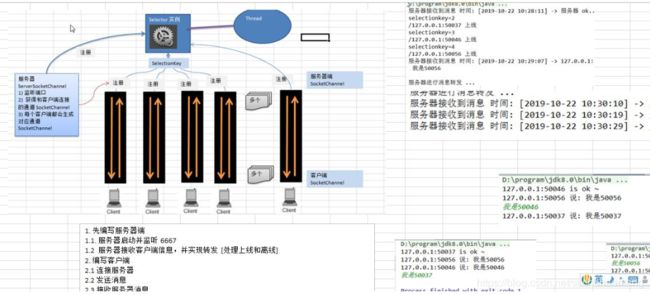
代码:
package com.wolfx.nio.groupchat;
import java.io.IOException;
import java.net.InetSocketAddress;
import java.nio.ByteBuffer;
import java.nio.channels.*;
import java.util.Iterator;
/**
* @description:
* @author: sukang
* @date: 2020-06-12 16:39
*/
public class GroupChatServer {
//定义属性
private Selector selector;
private ServerSocketChannel listenChannel;
private static final int PORT = 6667;
//构造器
//初始化工作
public GroupChatServer() {
try {
//得到选择器
selector = Selector.open();
//ServerSocketChannel
listenChannel = ServerSocketChannel.open();
//绑定端口
listenChannel.socket().bind(new InetSocketAddress(PORT));
//设置非阻塞模式
listenChannel.configureBlocking(false);
//将该listenChannel注册到selector
listenChannel.register(selector, SelectionKey.OP_ACCEPT);
} catch ( IOException e ) {
e.printStackTrace();
}
}
//监听
public void listen(){
try {
//循环处理
while(true){
int count = selector.select();
if(count > 0){ //有事件处理
//遍历得到selectionKey集合
Iterator<SelectionKey> iterator = selector.selectedKeys().iterator();
while (iterator.hasNext()){
//取出selectionkey
SelectionKey key = iterator.next();
//监听到accept
if(key.isAcceptable()){
SocketChannel sc = listenChannel.accept();
sc.configureBlocking(false);
//将该sc注册到seletor
sc.register(selector,SelectionKey.OP_READ);
//提示
System.out.println(sc.getRemoteAddress()+"上线");
}
if(key.isReadable()){//通道发送read事件,即通道是可读的状态
//处理读(专门写方法..)
readData(key);
}
//当前的key删除,防止重复处理
iterator.remove();
}
}else{
System.out.println("等待....");
}
}
} catch ( Exception e ) {
e.printStackTrace();
} finally {
//发生异常处理....
}
}
//读取客户端消息
private void readData(SelectionKey key){
//取到关联的channel
SocketChannel channel = null;
try {
//得到channel
channel = (SocketChannel)key.channel();
//创建buffer
ByteBuffer buffer = ByteBuffer.allocate(1024);
int count = channel.read(buffer);
if(count > 0){
//把缓存区的数据转成字符串
String msg = new String(buffer.array());
//输出该消息
System.out.println("from 客户端:" + msg);
//向其它的客户端转发消息(去掉自己),专门写一个方法来处理
sendInfoToOtherClients(msg,channel);
}
} catch ( IOException e ) {
try {
System.out.println(channel.getRemoteAddress() + "离线了..");
//取消注册
key.cancel();
//关闭通道
channel.close();
} catch ( IOException ex ) {
ex.printStackTrace();
}
}
}
//转发消息给其他客户(通道)
private void sendInfoToOtherClients(String msg, SocketChannel self) throws IOException{
System.out.println("服务器转发消息中...");
//遍历 所有注册到selector上的SocketChannel,并排除self
for (SelectionKey key : selector.keys()) {
//通过key取出对应的SocketChannel
Channel targetChannel = key.channel();
//排除自己
if(targetChannel instanceof SocketChannel && targetChannel != self){
//转型
SocketChannel dest = (SocketChannel) targetChannel;
//将msg存储到buffer
ByteBuffer buffer = ByteBuffer.wrap(msg.getBytes());
//将buffer的数据写入通道
dest.write(buffer);
}
}
}
public static void main(String[] args) {
//创建服务器对象
GroupChatServer groupChatServer = new GroupChatServer();
groupChatServer.listen();
}
}
package com.wolfx.nio.groupchat;
import java.io.IOException;
import java.net.InetSocketAddress;
import java.nio.ByteBuffer;
import java.nio.channels.SelectionKey;
import java.nio.channels.Selector;
import java.nio.channels.SocketChannel;
import java.util.Iterator;
import java.util.Scanner;
/**
* @description:
* @author: sukang
* @date: 2020-06-22 16:05
*/
public class GroupChatClient {
//定义相关的属性
private final String HOST = "127.0.0.1";//服务器的ip
private final int PORT = 6667;//服务器端口
private Selector selector;
private SocketChannel socketChannel;
private String username;
//构造器,完成初始化工作
public GroupChatClient() throws IOException {
selector = Selector.open();
//连接服务器
socketChannel = SocketChannel.open(new InetSocketAddress("127.0.0.1",PORT));
//设置非阻塞
socketChannel.configureBlocking(false);
//将channel注册到selector
socketChannel.register(selector, SelectionKey.OP_READ);
//得到username
username = socketChannel.getLocalAddress().toString().substring(1);
System.out.println(username + "is ok");
}
//向服务器发送消息
public void sendInfo(String info){
info = username + "说: " + info;
try {
socketChannel.write(ByteBuffer.wrap(info.getBytes()));
} catch ( IOException e ) {
e.printStackTrace();
}
}
//读取从服务器端回复的消息
public void readInfo(){
try {
int readChannels = selector.select();
if(readChannels > 0){//有可用的通道
Iterator<SelectionKey> iterator = selector.selectedKeys().iterator();
while (iterator.hasNext()){
SelectionKey key = iterator.next();
if(key.isReadable()){
//得到相关的通道
SocketChannel sc = (SocketChannel)key.channel();
//得到一个Buffer
ByteBuffer buffer = ByteBuffer.allocate(1024);
//读取
sc.read(buffer);
//把读到的缓冲区的数据转成字符串
String msg=new String(buffer.array());
System.out.println(msg.trim());
}
}
iterator.remove();//删除当前的selectionKey,防止重复操作
}else {
//System.out.println("没有可以用的通道...");
}
} catch ( IOException e ) {
e.printStackTrace();
}
}
public static void main(String[] args) throws Exception{
//启动我们客户端
final GroupChatClient chatClient=new GroupChatClient();
//启动一个线程,每个3秒,读取从服务器发送数据
new Thread(){
@Override
public void run(){
while (true){
chatClient.readInfo();
try {
sleep(3000);
} catch ( InterruptedException e ) {
e.printStackTrace();
}
}
}
}.start();
//发送数据给服务器端
Scanner scanner = new Scanner(System.in);
while (scanner.hasNextLine()){
String s = scanner.nextLine();
chatClient.sendInfo(s);
}
}
}
3.13 NIO与零拷贝
3.13.1 零拷贝基本介绍
- 零拷贝是网络编程的关键,很多性能优化都离不开。
- 在Java程序中,常用的零拷贝有mmap(内存映射)和sendFile。那么,他们在OS里,到底是怎么样的一个的设计?我们分析mmap和sendFile这两个零拷贝
- 另外我们看下NIO中如何使用零拷贝
3.13.2 传统IO数据读写
初学 Java 时,我们在学习 IO 和 网络编程时,会使用以下代码:
File file = new File("index.html");
RandomAccessFile raf = new RandomAccessFile(file, "rw");
byte[] arr = new byte[(int) file.length()];
raf.read(arr);
Socket socket = new ServerSocket(8080).accept();
socket.getOutputStream().write(arr);
我们会调用read方法读取index.html的内容—变成字节数组,然后调用write方法,将index.html字节流写到socket中,那么,我们调用者两个方法,在OS底层发生了什么呢?我这里借鉴了一张其他文字的图片,尝试解释这个过程
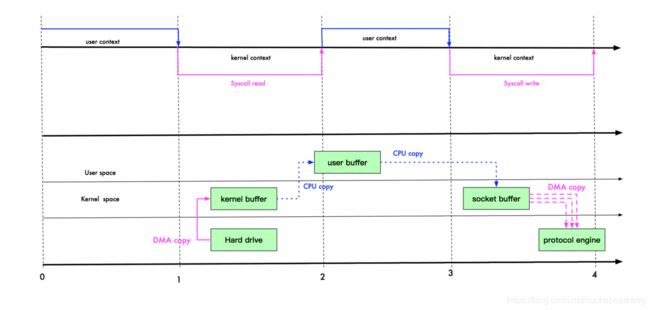
上图中,上半部分表示用户态和内核态的上下文切换。下半部分表示数据复制操作。下面说说他们的步骤:
- read 调用导致用户态到内核态的一次变化,同时,第一次复制开始:DMA(Direct Memory Access,直接内存存取,即不使用 CPU 拷贝数据到内存,而是 DMA 引擎传输数据到内存,用于解放 CPU) 引擎从磁盘读取 index.html 文件,并将数据放入到内核缓冲区。
- 发生第二次数据拷贝,即:将内核缓冲区的数据拷贝到用户缓冲区,同时,发生了一次用内核态到用户态的上下文切换。
- 发生第三次数据拷贝,我们调用 write 方法,系统将用户缓冲区的数据拷贝到 Socket 缓冲区。此时,又发生了一次用户态到内核态的上下文切换。
- 第四次拷贝,数据异步的从 Socket 缓冲区,使用 DMA 引擎拷贝到网络协议引擎。这一段,不需要进行上下文切换。
- write 方法返回,再次从内核态切换到用户态。
如你所见,复制拷贝操作太多了。如何优化这些流程?
mmap 优化
mmap 通过内存映射,将文件映射到内核缓冲区,同时,用户空间可以共享内核空间的数据。这样,在进行网络传输时,就可以减少内核空间到用户控件的拷贝次数。如下图:
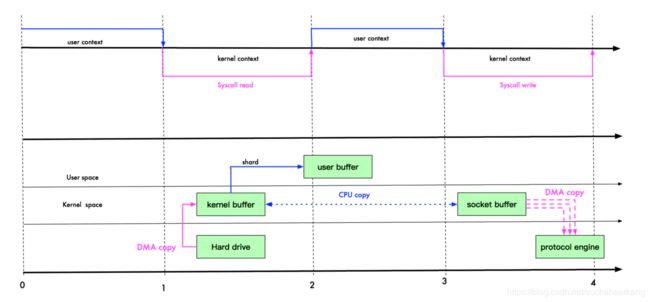
如上图,user buffer 和 kernel buffer 共享 index.html。如果你想把硬盘的 index.html 传输到网络中,再也不用拷贝到用户空间,再从用户空间拷贝到 Socket 缓冲区。
现在,你只需要从内核缓冲区拷贝到 Socket 缓冲区即可,这将减少一次内存拷贝(从 4 次变成了 3 次),但不减少上下文切换次数。
sendFile
那么,我们还能继续优化吗? Linux 2.1 版本 提供了 sendFile 函数,其基本原理如下:数据根本不经过用户态,直接从内核缓冲区进入到 Socket Buffer,同时,由于和用户态完全无关,就减少了一次上下文切换。

如上图,我们进行 sendFile 系统调用时,数据被 DMA 引擎从文件复制到内核缓冲区,然后调用,然后掉一共 write 方法时,从内核缓冲区进入到 Socket,这时,是没有上下文切换的,因为在一个用户空间。
最后,数据从 Socket 缓冲区进入到协议栈。
此时,数据经过了 3 次拷贝,3 次上下文切换。
那么,还能不能再继续优化呢? 例如直接从内核缓冲区拷贝到网络协议栈?
实际上,Linux 在 2.4 版本中,做了一些修改,避免了从内核缓冲区拷贝到 Socket buffer 的操作,直接拷贝到协议栈,从而再一次减少了数据拷贝。具体如下图:

现在,index.html 要从文件进入到网络协议栈,只需 2 次拷贝:第一次使用 DMA 引擎从文件拷贝到内核缓冲区,第二次从内核缓冲区将数据拷贝到网络协议栈;内核缓存区只会拷贝一些 offset 和 length 信息到 SocketBuffer,基本无消耗。
等一下,不是说零拷贝吗?为什么还是要 2 次拷贝?
答:首先我们说零拷贝,是从操作系统的角度来说的。因为内核缓冲区之间,没有数据是重复的(只有 kernel buffer 有一份数据,sendFile 2.1 版本实际上有 2 份数据,算不上零拷贝)。例如我们刚开始的例子,内核缓存区和 Socket 缓冲区的数据就是重复的。
而零拷贝不仅仅带来更少的数据复制,还能带来其他的性能优势,例如更少的上下文切换,更少的 CPU 缓存伪共享以及无 CPU 校验和计算。
再稍微讲讲 mmap 和 sendFile 的区别。
- mmap 适合小数据量读写,sendFile 适合大文件传输。
- mmap 需要 4 次上下文切换,3 次数据拷贝;sendFile 需要 3 次上下文切换,最少 2 次数据拷贝。
- sendFile 可以利用 DMA 方式,减少 CPU 拷贝,mmap 则不能(必须从内核拷贝到 Socket 缓冲区)。
在这个选择上:rocketMQ 在消费消息时,使用了 mmap。kafka 使用了 sendFile。
Java 世界的例子
kafka 在客户端和 broker 进行数据传输时,会使用 transferTo 和 transferFrom 方法,即对应 Linux 的 sendFile。
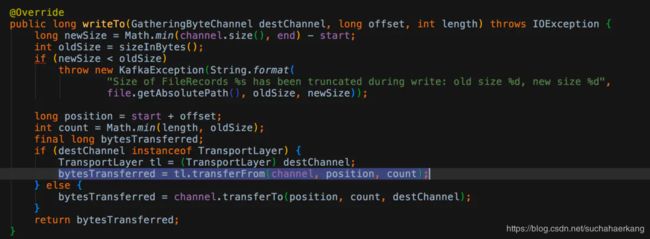
tomcat 内部在进行文件拷贝的时候,也会使用 transferto 方法。

tomcat 在处理一下心跳保活时,也会调用该 sendFile 方法。
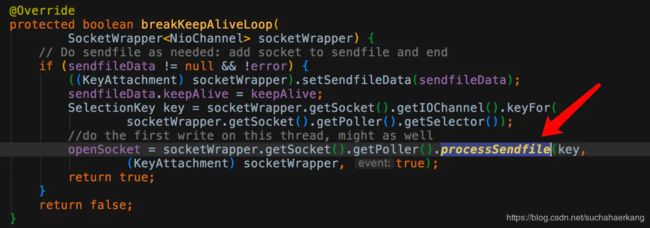
在 pulsar 项目中,下载文件时,也会使用 sendFile。如下图:

所以,如果你需要优化网络传输的性能,或者文件读写的速度,请尽量使用零拷贝。他不仅能较少复制拷贝次数,还能较少上下文切换,缓存行污染。
3.14 JavaAIO基本介绍
- JDK7引入了AsynchronousI/O,即AIO。在进行I/O编程中,常用到两种模式:Reactor和Proactor。Java的NIO就是Reactor,当有事件触发时,服务器端得到通知,进行相应的处理
- AIO即NIO2.0,叫做异步不阻塞的IO。AIO引入异步通道的概念,采用了Proactor模式,简化了程序编写,有效的请求才启动线程,它的特点是先由操作系统完成后才通知服务端程序启动线程去处理,一般适用于连接数较多且连接时间较长的应用
3.15 BIO、NIO、AIO对比表
4 Netty概述
4.1 原生NIO存在的问题
- NIO的类库和API繁杂,使用麻烦:需要熟练掌握Selector、ServerSocketChannel、SocketChannel、ByteBuffer等。
- 需要具备其他的额外技能:要熟悉Java多线程编程,因为NIO编程涉及到Reactor模式,你必须对多线程和网络编程非常熟悉,才能编写出高质量的NIO程序。
- 开发工作量和难度都非常大:例如客户端面临断连重连、网络闪断、半包读写、失败缓存、网络拥塞和异常流的处理等等。
- JDK NIO的Bug:例如臭名昭著的Epoll Bug,它会导致Selector空轮询,最终导致CPU100%。直到JDK1.7版本该问题仍旧存在,没有被根本解决。
4.2 Netty官网说明
官网:https://netty.io/
![]()
4.3 Netty的优点
Netty对JDK自带的NIO的API进行了封装,解决了上述问题。
- 设计优雅:适用于各种传输类型的统一API阻塞和非阻塞Socket;基于灵活且可扩展的事件模型,可以清晰地分离关注点;高度可定制的线程模型-单线程,一个或多个线程池.
- 使用方便:详细记录的Javadoc,用户指南和示例;没有其他依赖项,JDK5(Netty3.x)或6(Netty4.x)就足够了。
- 高性能、吞吐量更高:延迟更低;减少资源消耗;最小化不必要的内存复制。
- 安全:完整的SSL/TLS和StartTLS支持。
- 社区活跃、不断更新:社区活跃,版本迭代周期短,发现的Bug可以被及时修复,同时,更多的新功能会被加入
4.4 Netty版本说明
- netty版本分为netty3.x和netty4.x、netty5.x
- 因为Netty5出现重大bug,已经被官网废弃了,目前推荐使用的是Netty4.x的稳定版本
- 目前在官网可下载的版本netty3.xnetty4.0.x和netty4.1.x
- 在本套课程中,我们讲解Netty4.1.x版本
- netty下载地址:https://bintray.com/netty/downloads/netty/
5 Netty高性能架构设计
5.1 线程模型基本介绍
- 不同的线程模式,对程序的性能有很大影响,为了搞清Netty线程模式,我们来系统的讲解下各个线程模式,最后看看Netty线程模型有什么优越性.
- 目前存在的线程模型有:
传统阻塞I/O服务模型
Reactor模式 - 根据Reactor的数量和处理资源池线程的数量不同,有3种典型的实现
单Reactor单线程;
单Reactor多线程;
主从Reactor多线程 - Netty线程模式(Netty主要基于主从Reactor多线程模型做了一定的改进,其中主从Reactor多线程模型有多个Reactor)
5.2 传统阻塞I/O服务模型
5.2.1 工作原理图
- 黄色的框表示对象,蓝色的框表示线程
- 白色的框表示方法(API)
5.2.2 模型特点
- 采用阻塞IO模式获取输入的数据
- 每个连接都需要独立的线程完成数据的输入,业务处理,数据返回
5.2.3 问题分析
5.3 Reactor模式
5.3.1 针对传统阻塞I/O服务模型的2个缺点,解决方案:
- 基于I/O复用模型:多个连接共用一个阻塞对象,应用程序只需要在一个阻塞对象等待,无需阻塞等待所有连接。当某个连接有新的数据可以处理时,操作系统通知应用程序,线程从阻塞状态返回,开始进行业务处理Reactor对应的叫法:1.反应器模式 2.分发者模式(Dispatcher) 3.通知者模式(notifier)
- 基于线程池复用线程资源:不必再为每个连接创建线程,将连接完成后的业务处理任务分配给线程进行处理,一个线程可以处理多个连接的业务。

5.3.2 I/O复用结合线程池,就是Reactor模式基本设计思想,如图
- Reactor模式,通过一个或多个输入同时传递给服务处理器的模式(基于事件驱动)
- 服务器端程序处理传入的多个请求,并将它们同步分派到相应的处理线程,因此Reactor模式也叫Dispatcher模式
- Reactor模式使用IO复用监听事件,收到事件后,分发给某个线程(进程),这点就是网络服务器高并发处理关键
5.3.3 Reactor模式中核心组成:
- Reactor:Reactor在一个单独的线程中运行,负责监听和分发事件,分发给适当的处理程序来对IO事件做出反应。它就像公司的电话接线员,它接听来自客户的电话并将线路转移到适当的联系人;
- Handlers:处理程序执行I/O事件要完成的实际事件,类似于客户想要与之交谈的公司中的实际官员。Reactor通过调度适当的处理程序来响应I/O事件,处理程序执行非阻塞操作。
5.3.4 Reactor模式分类:
根据Reactor的数量和处理资源池线程的数量不同,有3种典型的实现
- 单Reactor单线程
- 单Reactor多线程
- 主从Reactor多线程
5.4 单Reactor单线程
5.4.1 方案说明:
- Select是前面I/O复用模型介绍的标准网络编程API,可以实现应用程序通过一个阻塞对象监听多路连接请求
- Reactor对象通过Select监控客户端请求事件,收到事件后通过Dispatch进行分发
- 如果是建立连接请求事件,则由Acceptor通过Accept处理连接请求,然后创建一个Handler对象处理连接完成后的后续业务处理
- 如果不是建立连接事件,则Reactor会分发调用连接对应的Handler来响应
- Handler会完成Read→业务处理→Send的完整业务流程
结合实例:服务器端用一个线程通过多路复用搞定所有的IO操作(包括连接,读、写等),编码简单,清晰明了,但是如果客户端连接数量较多,将无法支撑,前面的NIO案例就属于这种模型。
5.4.2 方案优缺点分析:
- 优点:模型简单,没有多线程、进程通信、竞争的问题,全部都在一个线程中完成
- 缺点:性能问题,只有一个线程,无法完全发挥多核CPU的性能。Handler在处理某个连接上的业务时,整个进程无法处理其他连接事件,很容易导致性能瓶颈
- 缺点:可靠性问题,线程意外终止,或者进入死循环,会导致整个系统通信模块不可用,不能接收和处理外部消息,造成节点故障
- 使用场景:客户端的数量有限,业务处理非常快速,比如Redis在业务处理的时间复杂度O(1)的情况
5.5 单Reactor多线程
5.5.1 原理图
5.5.2 对上图的小结
- Reactor对象通过select监控客户端请求事件,收到事件后,通过dispatch进行分发
- 如果建立连接请求,则又Acceptor通过accept处理连接请求,然后创建一个Handler对象处理完成连接后的各种事件
- 如果不是连接请求,则由reactor分发调用连接对应的handler来处理
- handler只负责响应事件,不做具体的业务处理,通过read读取数据后,会分发给后面的worker线程池的某个线程处理业务
- worker线程池会分配独立线程完成真正的业务,并将结果返回给handler
- handler收到响应后,通过send将结果返回给client
5.5.3 方案优缺点分析:
- 优点:可以充分的利用多核cpu的处理能力
- 缺点:多线程数据共享和访问比较复杂,reactor处理所有的事件的监听和响应,在单线程运行,在高并发场景容易出现性能瓶颈.
5.6 主从Reactor多线程
5.6.1 工作原理图
针对单Reactor多线程模型中,Reactor在单线程中运行,高并发场景下容易成为性能瓶颈,可以让Reactor在多线程中运行

5.6.2 上图的方案说明
- Reactor主线程MainReactor对象通过select监听连接事件,收到事件后,通过Acceptor处理连接事件
- 当Acceptor处理连接事件后,MainReactor将连接分配给SubReactor
- subreactor将连接加入到连接队列进行监听,并创建handler进行各种事件处理
- 当有新事件发生时,subreactor就会调用对应的handler处理
- handler通过read读取数据,分发给后面的worker线程处理
- worker线程池分配独立的worker线程进行业务处理,并返回结果
- handler收到响应的结果后,再通过send将结果返回给client
- Reactor主线程可以对应多个Reactor子线程,即MainRecator可以关联多个SubReactor
5.6.3ScalableIOinJava对MultipleReactors的原理图解:
5.6.4方案优缺点说明:
- 优点:父线程与子线程的数据交互简单职责明确,父线程只需要接收新连接,子线程完成后续的业务处理。
- 优点:父线程与子线程的数据交互简单,Reactor主线程只需要把新连接传给子线程,子线程无需返回数据。
- 缺点:编程复杂度较高
- 结合实例:这种模型在许多项目中广泛使用,包括Nginx主从Reactor多进程模型,Memcached主从多线程,Netty主从多线程模型的支持
5.7 Reactor模式小结
5.7.1 3种模式用生活案例来理解
- 单Reactor单线程,前台接待员和服务员是同一个人,全程为顾客服
- 单Reactor多线程,1个前台接待员,多个服务员,接待员只负责接待
- 主从Reactor多线程,多个前台接待员,多个服务生
5.7.2 Reactor模式具有如下的优点:
- 响应快,不必为单个同步时间所阻塞,虽然Reactor本身依然是同步的
- 可以最大程度的避免复杂的多线程及同步问题,并且避免了多线程/进程的切换开销
- 扩展性好,可以方便的通过增加Reactor实例个数来充分利用CPU资源
- 复用性好,Reactor模型本身与具体事件处理逻辑无关,具有很高的复用性
5.8Netty模型
5.8.1 工作原理示意图1-简单版
Netty主要基于主从Reactors多线程模型(如图)做了一定的改进,其中主从Reactor多线程模型有多个Reactor

5.8.2 对上图说明
- BossGroup线程维护Selector,只关注Accecpt
- 当接收到Accept事件,获取到对应的SocketChannel,封装成NIOScoketChannel并注册到Worker线程(事件循环),并进行维护
- 当Worker线程监听到selector中通道发生自己感兴趣的事件后,就进行处理(就由handler),注意handler已经加入到通道
5.8.3 工作原理示意图2-进阶版
5.8.4 工作原理示意图-详细版
5.8.5 对上图的说明小结
- Netty抽象出两组线程池BossGroup专门负责接收客户端的连接,WorkerGroup专门负责网络的读写
- BossGroup和WorkerGroup类型都是NioEventLoopGroup
- NioEventLoopGroup相当于一个事件循环组,这个组中含有多个事件循环,每一个事件循环是NioEventLoop
- NioEventLoop表示一个不断循环的执行处理任务的线程,每个NioEventLoop都有一个selector,用于监听绑定在其上的socket的网络通讯
- NioEventLoopGroup可以有多个线程,即可以含有多个NioEventLoop
- 每个BossNioEventLoop循环执行的步骤有3步
- 轮询accept事件
- 处理accept事件,与client建立连接,生成NioScocketChannel,并将其注册到某个workerNIOEventLoop上的selector
- 处理任务队列的任务,即runAllTasks
- 每个WorkerNIOEventLoop循环执行的步骤
- 轮询read,write事件
- 处理i/o事件,即read,write事件,在对应NioScocketChannel处理
- 处理任务队列的任务,即runAllTasks
- 每个WorkerNIOEventLoop处理业务时,会使用pipeline(管道),pipeline中包含了channel,即通过pipeline可以获取到对应通道,管道中维护了很多的处理器
5.8.6 Netty快速入门实例-TCP服务
- Netty服务器在6668端口监听,客户端能发送消息给服务器"hello,服务器~"
- 服务器可以回复消息给客户端"hello,客户端~"
- 目的:对Netty线程模型有一个初步认识,便于理解Netty模型理论
代码如下
package com.wolfx.netty.simple;
import io.netty.bootstrap.ServerBootstrap;
import io.netty.channel.ChannelFuture;
import io.netty.channel.ChannelInitializer;
import io.netty.channel.ChannelOption;
import io.netty.channel.EventLoopGroup;
import io.netty.channel.nio.NioEventLoopGroup;
import io.netty.channel.socket.SocketChannel;
import io.netty.channel.socket.nio.NioServerSocketChannel;
/**
* @description:
* @author: sukang
* @date: 2020-06-23 14:43
*/
public class NettyServer {
public static void main(String[] args) throws Exception {
//创建BossGroup和WorkerGroup
//说明
//1.创建两个线程组bossGroup和workerGroup
//2.bossGroup只是处理连接请求,真正的和客户端业务处理,会交给workerGroup完成
//3.两个都是无限循环
//4.bossGroup和workerGroup含有的子线程(NioEventLoop)的个数
//默认实际cpu核数*2
EventLoopGroup bossGroup = new NioEventLoopGroup(1);
EventLoopGroup workerGroup = new NioEventLoopGroup();
try {
//创建服务器端的启动对象,配置参数
ServerBootstrap bootstrap = new ServerBootstrap();
//使用链式编程来进行设置
bootstrap.group(bossGroup, workerGroup)//设置两个线程组
.channel(NioServerSocketChannel.class)//使用NioSocketChanel作为服务器的通道实现
.option(ChannelOption.SO_BACKLOG, 128)//设置线程队列得到连接个数
.childOption(ChannelOption.SO_KEEPALIVE,true)//设置保持活动连接状态
.childHandler(new ChannelInitializer<SocketChannel>(){//创建一个通道测试对象(匿名对象)
//给pipeline设置处理器
@Override
protected void initChannel(SocketChannel ch) throws Exception {
ch.pipeline().addLast(new NettyServerHandler());
}
});//给我们的workerGroup的EventLoop对应的管道设置处理器
System.out.println(".....服务器isready...");
//绑定一个端口并且同步,生成了一个ChannelFuture对象
//启动服务器(并绑定端口)
ChannelFuture cf=bootstrap.bind(6668).sync();
//对关闭通道进行监听
cf.channel().closeFuture().sync();
} finally {
bossGroup.shutdownGracefully();
workerGroup.shutdownGracefully();
}
}
}
package com.wolfx.netty.simple;
import io.netty.buffer.ByteBuf;
import io.netty.buffer.Unpooled;
import io.netty.channel.Channel;
import io.netty.channel.ChannelHandlerContext;
import io.netty.channel.ChannelInboundHandlerAdapter;
import io.netty.channel.ChannelPipeline;
import io.netty.util.CharsetUtil;
/**
* @description:
* 1.我们自定义一个Handler需要继续netty规定好的某个HandlerAdapter(规范)
* 2.这时我们自定义一个Handler,才能称为一个handler
* @author: sukang
* @date: 2020-06-23 16:01
*/
public class NettyServerHandler extends ChannelInboundHandlerAdapter {
//读取数据实际(这里我们可以读取客户端发送的消息)
/**
* @description:
* 1.ChannelHandlerContextctx:上下文对象,含有管道pipeline,通道channel,地址
* 2.Object msg:就是客户端发送的数据默认Object
* @param ctx
* @param msg
* @return: void
* @author: sukang
* @date: 2020/6/23 16:03
*/
@Override
public void channelRead(ChannelHandlerContext ctx, Object msg) throws Exception {
System.out.println("服务器读取线程" + Thread.currentThread().getName());
System.out.println("server ctx=" + ctx);
System.out.println("看看channel和pipeline的关系");
Channel channel = ctx.channel();
ChannelPipeline pipeline = ctx.pipeline();//本质是一个双向链接,出站入站
//将msg转成一个ByteBuf
//ByteBuf是Netty提供的,不是NIO的ByteBuffer.
ByteBuf buf = (ByteBuf)msg;
System.out.println("客户端发送消息是:"+buf.toString(CharsetUtil.UTF_8));
System.out.println("客户端地址:"+channel.remoteAddress());
}
//数据读取完毕
@Override
public void channelReadComplete(ChannelHandlerContext ctx) throws Exception {
//writeAndFlush 是write + flush
//将数据写入到缓存,并刷新
//一般讲,我们对这个发送的数据进行编码
ctx.writeAndFlush(Unpooled.copiedBuffer("hello,客户端~(>^ω^<)喵",CharsetUtil.UTF_8));
}
//处理异常,一般是需要关闭通道
@Override
public void exceptionCaught(ChannelHandlerContext ctx, Throwable cause) throws Exception {
ctx.close();
}
}
package com.wolfx.netty.simple;
import io.netty.bootstrap.Bootstrap;
import io.netty.channel.ChannelFuture;
import io.netty.channel.ChannelInitializer;
import io.netty.channel.EventLoopGroup;
import io.netty.channel.nio.NioEventLoopGroup;
import io.netty.channel.socket.SocketChannel;
import io.netty.channel.socket.nio.NioSocketChannel;
/**
* @description:
* @author: sukang
* @date: 2020-06-23 16:15
*/
public class NettyClient {
public static void main(String[] args) throws Exception{
//客户端需要一个事件循环组
EventLoopGroup group = new NioEventLoopGroup();
try {
//创建客户端启动对象
//注意客户端使用的不是 ServerBootstrap 而是 Bootstrap
Bootstrap bootstrap = new Bootstrap();
//设置相关参数
bootstrap.group(group) //设置线程组
.channel(NioSocketChannel.class) // 设置客户端通道的实现类(反射)
.handler(new ChannelInitializer<SocketChannel>() {
@Override
protected void initChannel(SocketChannel ch) throws Exception {
ch.pipeline().addLast(new NettyClientHandler()); //加入自己的处理器
}
});
System.out.println("客户端 ok..");
//启动客户端去连接服务器端
//关于 ChannelFuture 要分析,涉及到netty的异步模型
ChannelFuture channelFuture = bootstrap.connect("127.0.0.1", 6668).sync();
//给关闭通道进行监听
channelFuture.channel().closeFuture().sync();
}finally {
group.shutdownGracefully();
}
}
}
package com.wolfx.netty.simple;
import io.netty.buffer.ByteBuf;
import io.netty.buffer.Unpooled;
import io.netty.channel.ChannelHandlerContext;
import io.netty.channel.ChannelInboundHandlerAdapter;
import io.netty.util.CharsetUtil;
public class NettyClientHandler extends ChannelInboundHandlerAdapter {
//当通道就绪就会触发该方法
@Override
public void channelActive(ChannelHandlerContext ctx) throws Exception {
System.out.println("client " + ctx);
ctx.writeAndFlush(Unpooled.copiedBuffer("hello, server: (>^ω^<)喵", CharsetUtil.UTF_8));
}
//当通道有读取事件时,会触发
@Override
public void channelRead(ChannelHandlerContext ctx, Object msg) throws Exception {
ByteBuf buf = (ByteBuf) msg;
System.out.println("服务器回复的消息:" + buf.toString(CharsetUtil.UTF_8));
System.out.println("服务器的地址: "+ ctx.channel().remoteAddress());
}
@Override
public void exceptionCaught(ChannelHandlerContext ctx, Throwable cause) throws Exception {
cause.printStackTrace();
ctx.close();
}
}
5.8.7 任务队列中的Task有3种典型使用场景
- 用户程序自定义的普通任务
- 用户自定义定时任务
- 非当前Reactor线程调用Channel的各种方法
例如在推送系统的业务线程里面,根据用户的标识,找到对应的Channel引用,然后调用Write类方法向该用户推送消息,就会进入到这种场景。最终的Write会提交到任务队列中后被异步消费 - 代码演示
package com.wolfx.netty.simple;
import io.netty.buffer.Unpooled;
import io.netty.channel.ChannelHandlerContext;
import io.netty.channel.ChannelInboundHandlerAdapter;
import io.netty.util.CharsetUtil;
import java.util.concurrent.TimeUnit;
/*
说明
1. 我们自定义一个Handler 需要继续netty 规定好的某个HandlerAdapter(规范)
2. 这时我们自定义一个Handler , 才能称为一个handler
*/
public class NettyServerHandler extends ChannelInboundHandlerAdapter {
//读取数据实际(这里我们可以读取客户端发送的消息)
/*
1. ChannelHandlerContext ctx:上下文对象, 含有 管道pipeline , 通道channel, 地址
2. Object msg: 就是客户端发送的数据 默认Object
*/
@Override
public void channelRead(ChannelHandlerContext ctx, Object msg) throws Exception {
//比如这里我们有一个非常耗时长的业务-> 异步执行 -> 提交该channel 对应的
//NIOEventLoop 的 taskQueue中,
//解决方案1 用户程序自定义的普通任务
ctx.channel().eventLoop().execute(new Runnable() {
@Override
public void run() {
try {
Thread.sleep(5 * 1000);
ctx.writeAndFlush(Unpooled.copiedBuffer("hello, 客户端~(>^ω^<)喵2", CharsetUtil.UTF_8));
System.out.println("channel code=" + ctx.channel().hashCode());
} catch (Exception ex) {
System.out.println("发生异常" + ex.getMessage());
}
}
});
ctx.channel().eventLoop().execute(new Runnable() {
@Override
public void run() {
try {
Thread.sleep(5 * 1000);
ctx.writeAndFlush(Unpooled.copiedBuffer("hello, 客户端~(>^ω^<)喵3", CharsetUtil.UTF_8));
System.out.println("channel code=" + ctx.channel().hashCode());
} catch (Exception ex) {
System.out.println("发生异常" + ex.getMessage());
}
}
});
//解决方案2 : 用户自定义定时任务 -》 该任务是提交到 scheduleTaskQueue中
ctx.channel().eventLoop().schedule(new Runnable() {
@Override
public void run() {
try {
Thread.sleep(5 * 1000);
ctx.writeAndFlush(Unpooled.copiedBuffer("hello, 客户端~(>^ω^<)喵4", CharsetUtil.UTF_8));
System.out.println("channel code=" + ctx.channel().hashCode());
} catch (Exception ex) {
System.out.println("发生异常" + ex.getMessage());
}
}
}, 5, TimeUnit.SECONDS);
System.out.println("go on ...");
// System.out.println("服务器读取线程 " + Thread.currentThread().getName() + " channle =" + ctx.channel());
// System.out.println("server ctx =" + ctx);
// System.out.println("看看channel 和 pipeline的关系");
// Channel channel = ctx.channel();
// ChannelPipeline pipeline = ctx.pipeline(); //本质是一个双向链接, 出站入站
//
//
// //将 msg 转成一个 ByteBuf
// //ByteBuf 是 Netty 提供的,不是 NIO 的 ByteBuffer.
// ByteBuf buf = (ByteBuf) msg;
// System.out.println("客户端发送消息是:" + buf.toString(CharsetUtil.UTF_8));
// System.out.println("客户端地址:" + channel.remoteAddress());
}
//数据读取完毕
@Override
public void channelReadComplete(ChannelHandlerContext ctx) throws Exception {
//writeAndFlush 是 write + flush
//将数据写入到缓存,并刷新
//一般讲,我们对这个发送的数据进行编码
ctx.writeAndFlush(Unpooled.copiedBuffer("hello, 客户端~(>^ω^<)喵1", CharsetUtil.UTF_8));
}
//处理异常, 一般是需要关闭通道
@Override
public void exceptionCaught(ChannelHandlerContext ctx, Throwable cause) throws Exception {
ctx.close();
}
}
5.8.8 方案再说明
- Netty抽象出两组线程池,BossGroup专门负责接收客户端连接,WorkerGroup专门负责网络读写操作。
- NioEventLoop表示一个不断循环执行处理任务的线程,每个NioEventLoop都有一个selector,用于监听绑定在其上的socket网络通道。
- NioEventLoop内部采用串行化设计,从消息的读取->解码->处理->编码->发送,始终由IO线程NioEventLoop负责
NioEventLoopGroup下包含多个NioEventLoop
每个NioEventLoop中包含有一个Selector,一个taskQueue
每个NioChannel只会绑定在唯一的NioEventLoop上
每个NioChannel都绑定有一个自己的ChannelPipeline
5.9 异步模型
5.9.1 基本介绍
- 异步的概念和同步相对。当一个异步过程调用发出后,调用者不能立刻得到结果。实际处理这个调用的组件在完成后,通过状态、通知和回调来通知调用者。
- Netty中的I/O操作是异步的,包括Bind、Write、Connect等操作会简单的返回一个ChannelFuture。
- 调用者并不能立刻获得结果,而是通过Future-Listener机制,用户可以方便的主动获取或者通过通知机制获得IO操作结果
- Netty的异步模型是建立在future和callback的之上的。callback就是回调。重点说Future,它的核心思想是:假设一个方法fun,计算过程可能非常耗时,等待fun返回显然不合适。那么可以在调用fun的时候,立马返回一个Future,后续可以通过Future去监控方法fun的处理过程(即:Future-Listener机制)
5.9.2 Future说明
- 表示异步的执行结果,可以通过它提供的方法来检测执行是否完成,比如检索计算等等.
- ChannelFuture是一个接口:publicinterfaceChannelFutureextendsFuture我们可以添加监听器,当监听的事件发生时,就会通知到监听器.案例说明
5.9.3 工作原理示意图
- 在使用Netty进行编程时,拦截操作和转换出入站数据只需要您提供callback或利用future即可。这使得链式操作简单、高效,并有利于编写可重用的、通用的代码。
- Netty框架的目标就是让你的业务逻辑从网络基础应用编码中分离出来、解脱出来
5.9.4 Future-Listener机制
- 当Future对象刚刚创建时,处于非完成状态,调用者可以通过返回的ChannelFuture来获取操作执行的状态,注册监听函数来执行完成后的操作。
- 常见有如下操作
通过isDone方法来判断当前操作是否完成;
通过isSuccess方法来判断已完成的当前操作是否成功;
通过getCause方法来获取已完成的当前操作失败的原因;
通过isCancelled方法来判断已完成的当前操作是否被取消;
通过addListener方法来注册监听器,当操作已完成(isDone方法返回完成),将会通知指定的监听器;如果Future对象已完成,则通知指定的监听器
5.10 快速入门实例-HTTP服务
- 实例要求:使用IDEA创建Netty项目
- Netty服务器在6668端口监听,浏览器发出请求"http://localhost:6668/"
- 服务器可以回复消息给客户端"Hello!我是服务器5",并对特定请求资源进行过滤.
- 目的:Netty可以做Http服务开发,并且理解Handler实例和客户端及其请求的关系.
- 看老师代码演示
package com.wolfx.netty.http;
import io.netty.bootstrap.ServerBootstrap;
import io.netty.channel.ChannelFuture;
import io.netty.channel.EventLoopGroup;
import io.netty.channel.nio.NioEventLoopGroup;
import io.netty.channel.socket.nio.NioServerSocketChannel;
/**
* @description:
* @author: sukang
* @date: 2020-06-24 10:58
*/
public class TestServer {
public static void main(String[] args) throws Exception{
EventLoopGroup bossGroup = new NioEventLoopGroup(1);
EventLoopGroup workerGroup = new NioEventLoopGroup();
try {
ServerBootstrap serverBootstrap = new ServerBootstrap();
serverBootstrap.group(bossGroup, workerGroup)
.channel(NioServerSocketChannel.class)
.childHandler(new TestServerInitializer());
ChannelFuture channelFuture = serverBootstrap.bind(6668).sync();
channelFuture.channel().closeFuture().sync();
}finally {
bossGroup.shutdownGracefully();
workerGroup.shutdownGracefully();
}
}
}
package com.wolfx.netty.http;
import io.netty.channel.ChannelInitializer;
import io.netty.channel.ChannelPipeline;
import io.netty.channel.socket.SocketChannel;
import io.netty.handler.codec.http.HttpServerCodec;
/**
* @description:
* @author: sukang
* @date: 2020-06-24 11:09
*/
public class TestServerInitializer extends ChannelInitializer<SocketChannel> {
@Override
protected void initChannel(SocketChannel ch) throws Exception {
//向管道加入处理器
//得到管道
ChannelPipeline pipeline= ch.pipeline();
//加入一个netty提供的 httpServerCodec codec=>[coder-decoder]
//HttpServerCodec说明
//1.HttpServerCodec是netty提供的处理http的编-解码器
pipeline.addLast("MyHttpServerCodec",new HttpServerCodec());
//2.增加一个自定义的handler
pipeline.addLast("MyTestHttpServerHandler",new TestHttpServerHandler());
}
}
package com.wolfx.netty.http;
import io.netty.buffer.ByteBuf;
import io.netty.buffer.Unpooled;
import io.netty.channel.ChannelHandlerContext;
import io.netty.channel.SimpleChannelInboundHandler;
import io.netty.handler.codec.http.*;
import io.netty.util.CharsetUtil;
import java.net.URI;
/*
说明
1. SimpleChannelInboundHandler 是 ChannelInboundHandlerAdapter
2. HttpObject 客户端和服务器端相互通讯的数据被封装成 HttpObject
*/
public class TestHttpServerHandler extends SimpleChannelInboundHandler<HttpObject> {
//channelRead0 读取客户端数据
@Override
protected void channelRead0(ChannelHandlerContext ctx, HttpObject msg) throws Exception {
System.out.println("对应的channel=" + ctx.channel() + " pipeline=" + ctx
.pipeline() + " 通过pipeline获取channel" + ctx.pipeline().channel());
System.out.println("当前ctx的handler=" + ctx.handler());
//判断 msg 是不是 httprequest请求
if(msg instanceof HttpRequest) {
System.out.println("ctx 类型="+ctx.getClass());
System.out.println("pipeline hashcode" + ctx.pipeline().hashCode() + " TestHttpServerHandler hash=" + this.hashCode());
System.out.println("msg 类型=" + msg.getClass());
System.out.println("客户端地址" + ctx.channel().remoteAddress());
//获取到
HttpRequest httpRequest = (HttpRequest) msg;
//获取uri, 过滤指定的资源
URI uri = new URI(httpRequest.uri());
if("/favicon.ico".equals(uri.getPath())) {
System.out.println("请求了 favicon.ico, 不做响应");
return;
}
//回复信息给浏览器 [http协议]
ByteBuf content = Unpooled.copiedBuffer("hello, 我是服务器", CharsetUtil.UTF_8);
//构造一个http的相应,即 httpresponse
FullHttpResponse response = new DefaultFullHttpResponse(HttpVersion.HTTP_1_1, HttpResponseStatus.OK, content);
response.headers().set(HttpHeaderNames.CONTENT_TYPE, "text/plain");
response.headers().set(HttpHeaderNames.CONTENT_LENGTH, content.readableBytes());
//将构建好 response返回
ctx.writeAndFlush(response);
}
}
}
6 Netty核心模块组件
6.1 Bootstrap、ServerBootstrap
- Bootstrap意思是引导,一个Netty应用通常由一个Bootstrap开始,主要作用是配置整个Netty程序,串联各个组件,Netty中Bootstrap类是客户端程序的启动引导类,ServerBootstrap是服务端启动引导类
- 常见的方法有
public ServerBootstrap group(EventLoopGroupparentGroup,EventLoopGroupchildGroup),该方法用于服务器端,用来设置两个EventLoop
public B group(EventLoopGroup group),该方法用于客户端,用来设置一个EventLoop
public B channel(Class channelClass),该方法用来设置一个服务器端的通道实现
public B option(ChannelOptionoption, T value),用来给ServerChannel添加配置
public ServerBootstrap childOption(ChannelOption childOption,T value),用来给接收到的通道添加配置
public ServerBootstrap childHandler(ChannelHandler childHandler),该方法用来设置业务处理类(自定义的handler)
public ChannelFuture bind(int inetPort),该方法用于服务器端,用来设置占用的端口号
public ChannelFuture connect(String inetHost, int inetPort),该方法用于客户端,用来连接服务器端
6.2 Future、ChannelFuture
Netty中所有的IO操作都是异步的,不能立刻得知消息是否被正确处理。但是可以过一会等它执行完成或者直接注册一个监听,具体的实现就是通过Future和ChannelFutures,他们可以注册一个监听,当操作执行成功或失败时监听会自动触发注册的监听事件
常见的方法有
Channel channel(),返回当前正在进行IO操作的通道
ChannelFuture sync(),等待异步操作执行完毕
6.3 Channel
- Netty网络通信的组件,能够用于执行网络I/O操作。
- 通过Channel可获得当前网络连接的通道的状态
- 通过Channel可获得网络连接的配置参数(例如接收缓冲区大小)
- Channel提供异步的网络I/O操作(如建立连接,读写,绑定端口),异步调用意味着任何I/O调用都将立即返回,并且不保证在调用结束时所请求的I/O操作已完成
- 调用立即返回一个ChannelFuture实例,通过注册监听器到ChannelFuture上,可以I/O操作成功、失败或取消时回调通知调用方
- 支持关联I/O操作与对应的处理程序
- 不同协议、不同的阻塞类型的连接都有不同的Channel类型与之对应,常用的Channel类型:
NioSocketChannel,异步的客户端TCPSocket连接。
NioServerSocketChannel,异步的服务器端TCPSocket连接。
NioDatagramChannel,异步的UDP连接。
NioSctpChannel,异步的客户端Sctp连接。
NioSctpServerChannel,异步的Sctp服务器端连接,这些通道涵盖了UDP和TCP网络IO以及文件IO。
6.4 Selector
- Netty基于Selector对象实现I/O多路复用,通过Selector一个线程可以监听多个连接的Channel事件。
- 当向一个Selector中注册Channel后,Selector内部的机制就可以自动不断地查询(Select)这些注册的Channel是否有已就绪的I/O事件(例如可读,可写,网络连接完成等),这样程序就可以很简单地使用一个线程高效地管理多个Channel
6.5 ChannelHandler及其实现类
- ChannelHandler是一个接口,处理I/O事件或拦截I/O操作,并将其转发到其ChannelPipeline(业务处理链)中的下一个处理程序。
- ChannelHandler本身并没有提供很多方法,因为这个接口有许多的方法需要实现,方便使用期间,可以继承它的子类
- ChannelHandler及其实现类一览图(后)
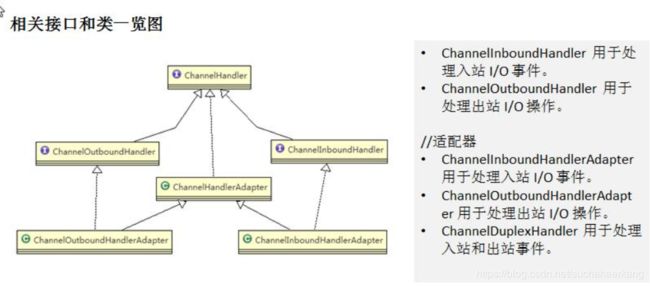
- 我们经常需要自定义一个Handler类去继承ChannelInboundHandlerAdapter,然后通过重写相应方法实现业务逻辑,我们接下来看看一般都需要重写哪些方法
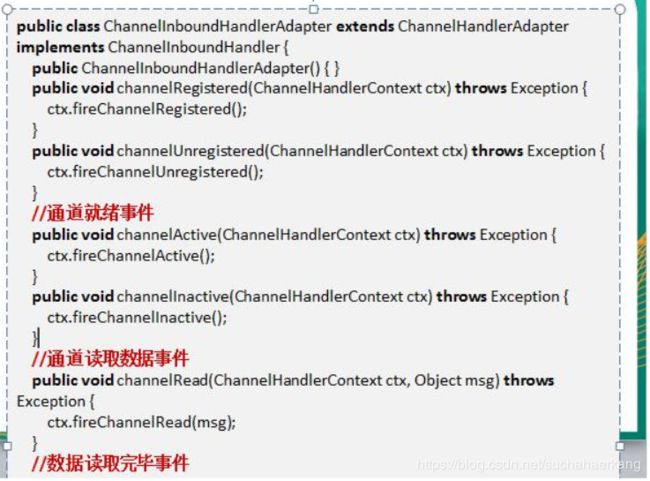
6.6 Pipeline和ChannelPipeline
ChannelPipeline是一个重点:
- ChannelPipeline是一个Handler的集合,它负责处理和拦截inbound或者outbound的事件和操作,相当于一个贯穿Netty的链。(也可以这样理解:ChannelPipeline是保存ChannelHandler的List,用于处理或拦截Channel的入站事件和出站操作)
- ChannelPipeline实现了一种高级形式的拦截过滤器模式,使用户可以完全控制事件的处理方式,以及Channel中各个的ChannelHandler如何相互交互
- 在Netty中每个Channel都有且仅有一个ChannelPipeline与之对应,它们的组成关系如下
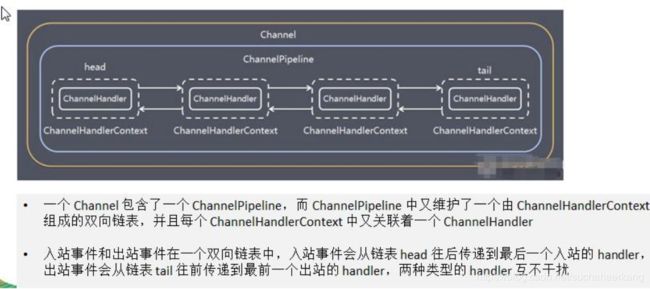
- 常用方法
ChannelPipeline addFirst(ChannelHandler…handlers),把一个业务处理类(handler)添加到链中的第一个位置
ChannelPipeline addLast(ChannelHandler…handlers),把一个业务处理类(handler)添加到链中的最后一个位置
6.7 ChannelHandlerContext
- 保存Channel相关的所有上下文信息,同时关联一个ChannelHandler对象
- 即ChannelHandlerContext中包含一个具体的事件处理器ChannelHandler,同时ChannelHandlerContext中也绑定了对应的pipeline和Channel的信息,方便对ChannelHandler进行调用.
- 常用方法

6.8 ChannelOption
6.9 EventLoopGroup和其实现类NioEventLoopGroup
- EventLoopGroup是一组EventLoop的抽象,Netty为了更好的利用多核CPU资源,一般会有多个EventLoop同时工作,每个EventLoop维护着一个Selector实例。
- EventLoopGroup提供next接口,可以从组里面按照一定规则获取其中一个EventLoop来处理任务。在Netty服务器端编程中,我们一般都需要提供两个EventLoopGroup,例如:BossEventLoopGroup和WorkerEventLoopGroup。
- 通常一个服务端口即一个ServerSocketChannel对应一个Selector和一个EventLoop线程。BossEventLoop负责接收客户端的连接并将SocketChannel交给WorkerEventLoopGroup来进行IO处理,如下图所示
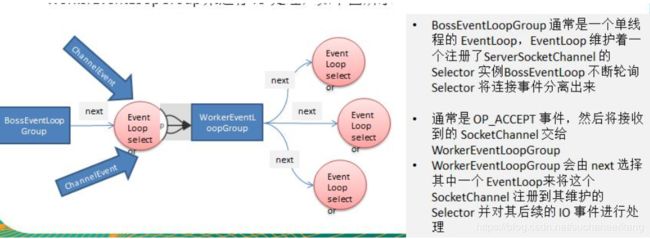
- 常用方法
public NioEventLoopGroup(),构造方法
public Future shutdownGracefully(),断开连接,关闭线程
6.10Unpooled类
7 Google Protobuf
7.1 编码和解码的基本介绍
- 编写网络应用程序时,因为数据在网络中传输的都是二进制字节码数据,在发送数据时就需要编码,接收数据时就需要解码
- codec(编解码器)的组成部分有两个:decoder(解码器)和encoder(编码器)。encoder负责把业务数据转换成字节码数据,decoder负责把字节码数据转换成业务数据

7.2 Netty本身的编码解码的机制和问题分析
- Netty自身提供了一些codec(编解码器)
- Netty提供的编码器
StringEncoder,对字符串数据进行编码
ObjectEncoder,对Java对象进行编码
… - Netty提供的解码器
StringDecoder,对字符串数据进行解码
ObjectDecoder,对Java对象进行解码
… - Netty本身自带的ObjectDecoder和ObjectEncoder可以用来实现POJO对象或各种业务对象的编码和解码,底层使用的仍是Java序列化技术,而Java序列化技术本身效率就不高,存在如下问题无法跨语言
序列化后的体积太大,是二进制编码的5倍多。
序列化性能太低 - =>引出新的解决方案[Google的Protobuf]
7.3 Protobuf
- Protobuf基本介绍和使用示意图
- Protobuf是Google发布的开源项目,全称GoogleProtocolBuffers,是一种轻便高效的结构化数据存储格式,可以用于结构化数据串行化,或者说序列化。它很适合做数据存储或RPC[远程过程调用remoteprocedurecall]数据交换格式。
目前很多公司http+json tcp+protobuf - 参考文档:https://developers.google.com/protocol-buffers/docs/proto语言指南
- Protobuf是以message的方式来管理数据的.
- 支持跨平台、跨语言,即[客户端和服务器端可以是不同的语言编写的](支持目前绝大多数语言,例如C++、C#、Java、python等)
- 高性能,高可靠性
- 使用protobuf编译器能自动生成代码,Protobuf是将类的定义使用.proto文件进行描述。说明,在idea中编写.proto文件时,会自动提示是否下载.ptotot编写插件.可以让语法高亮。
- 然后通过protoc.exe编译器根据.proto自动生成.java文件
- protobuf使用示意图

8 TCP粘包和拆包及解决方案
8.1 TCP粘包和拆包基本介绍
- TCP是面向连接的,面向流的,提供高可靠性服务。收发两端(客户端和服务器端)都要有一一成对的socket,因此,发送端为了将多个发给接收端的包,更有效的发给对方,使用了优化方法(Nagle算法),将多次间隔较小且数据量小的数据,合并成一个大的数据块,然后进行封包。这样做虽然提高了效率,但是接收端就难于分辨出完整的数据包了,因为面向流的通信是无消息保护边界的
- 由于TCP无消息保护边界,需要在接收端处理消息边界问题,也就是我们所说的粘包、拆包问题,看一张图
- 示意图TCP粘包、拆包图解
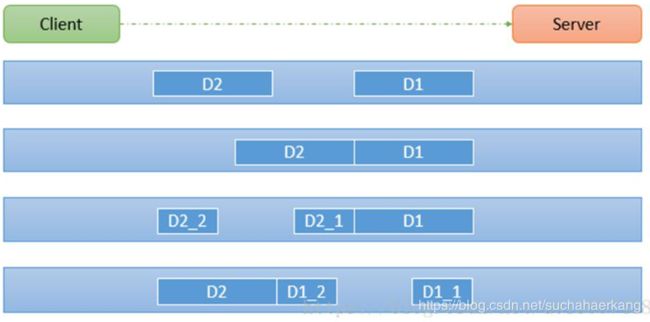
对图的说明:
假设客户端分别发送了两个数据包D1和D2给服务端,由于服务端一次读取到字节数是不确定的,故可能存在以下四种情况:
- 服务端分两次读取到了两个独立的数据包,分别是D1和D2,没有粘包和拆包
- 服务端一次接受到了两个数据包,D1和D2粘合在一起,称之为TCP粘包
- 服务端分两次读取到了数据包,第一次读取到了完整的D1包和D2包的部分内容,第二次读取到了D2包的剩余内容,这称之为TCP拆包
- 服务端分两次读取到了数据包,第一次读取到了D1包的部分内容D1_1,第二次读取到了D1包的剩余部分内容D1_2和完整的D2包。
8.3TCP粘包和拆包解决方案
- 使用自定义协议+编解码器来解决
- 关键就是要解决服务器端每次读取数据长度的问题,这个问题解决,就不会出现服务器多读或少读数据的问题,从而避免的TCP粘包、拆包。
